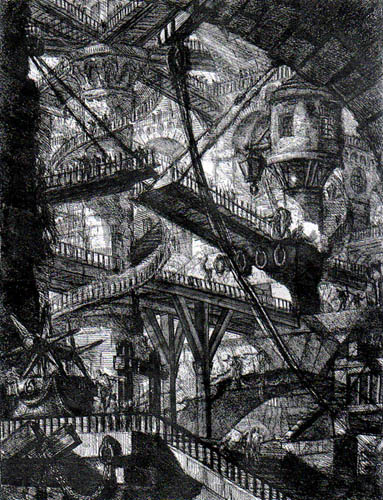
Giovanni Battista Piranesi. Tower with Bridges, from Prison Caprices. 1760-61.
Etching, 55.2 x 41.6 cm. The Metropolitan Museum of Art, New York
I have always been fascinated with Piranesi’s Tower with Bridges. This work is part of a suite of 16 etching he made of imaginary prisons between 1760-61. He created architectural spaces that seemed to recede indefinitely in all directions and was filled with endless stairwells surrounded by a multitude of cables, pulleys, and levers. The spaces were complex, full of arches, vaults and continuous pathways and extremely mesmerizing.
In my previous post about bridges and how we could think of them as non-places the same could be said about stairwells. Stairwells are designed to bridge a large vertical distance into smaller manageable vertical distances. Stairwells do not arrange space but instead merge elevations together providing easy access to all levels without confusion. But what happens if stairways are made to do the exact opposite? What if they are constructed to complicate our notion of space and our ideas of connection. Here is a series of stairwells created by artist’s that confuse and twist our perceived logic of a staircase.
 Do-ho Suh Staircase (2003) at the 8th Istanbul Biennial
Do-ho Suh Staircase (2003) at the 8th Istanbul Biennial

Do-Ho Suh, Staircase-V, 2008

 Michael Elmgreen and Ingar Dragset, Social Mobility (Staircase) (2005), Aluminium, wood, iron, and concrete
Michael Elmgreen and Ingar Dragset, Social Mobility (Staircase) (2005), Aluminium, wood, iron, and concrete

Henry Krokatsis, The Artists’ Playground, 2008

 Rachel Whiteread, Untitled (stairs), 2001, mixed m
Rachel Whiteread, Untitled (stairs), 2001, mixed m
 Peter Coffin, Untitled (Spiral Staircase), 2007, aluminum and steel
Peter Coffin, Untitled (Spiral Staircase), 2007, aluminum and steel

 Olafur Eliasson, Umschreibung (Rewriting), 2004
Olafur Eliasson, Umschreibung (Rewriting), 2004

 Michel de Broin, Revolution, 2010, Steel
Michel de Broin, Revolution, 2010, Steel

 Sabina Lang & Daniel Bauman, Beautiful Steps #2 – 2009, Biel-Bienne CH, “Utopics. 11. Schweizerische Plastikausstellung”
Sabina Lang & Daniel Bauman, Beautiful Steps #2 – 2009, Biel-Bienne CH, “Utopics. 11. Schweizerische Plastikausstellung”


Hey, love the Peter Coffin one, a perfect infinite loop, i somehow feel they should not expose it leaning against a wall thought. The one in Munchen is a classic for sure, so elegant! great post…
Thanks.
Pingback: Winchester Mystery House | citymovement·